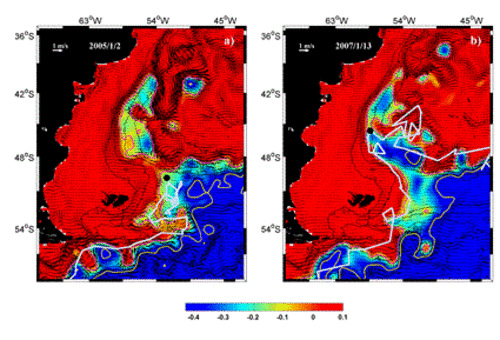Abstract's details
Malvinas Current variations: dissipation of mesoscale activity over the Malvinas Plateau and recurrent blocking events in the Argentine Basin.
CoAuthors
Event: 2016 Ocean Surface Topography Science Team Meeting
Session: Science II: From large-scale oceanography to coastal and shelf processes
Presentation type: Type Poster
Contribution: not provided
Abstract:
The Malvinas Current (MC) is an offshoot of the Antarctic Circumpolar Current (ACC). Downstream of Drake Passage, the northern fronts of the ACC veer northward, cross over the North Scotia Ridge (NSR) and the Malvinas Plateau and enter the Argentine Basin. We investigate the variations of the MC circulation between the NSR and 41°S and their possible relations with the ACC circulation using data from Argo floats and satellite altimetry.
The data depict meandering and eddy-shedding of the northern ACC jets as they cross the NSR. The satellite fields (altimetry and high resolution sea surface temperature images) show that these eddies are trapped, break down and dissipate over the Malvinas Plateau, suggesting that this region is a hot spot for dissipation of mesoscale variability. Variations of sea level anomalies (SLA) across the NSR do not impact the MC further north, except for intra-seasonal variability associated with coastal trapped waves.
Altimetry and float trajectories show events during which a large fraction of the MC is cut off from the ACC (see figures below). During these blocking events, the MC does not collapse as a robust cyclonic cell is established to the north of the cut-off. The MC becomes the western boundary current of the cell and small cyclonic eddies locally reinforce the circulation. Blocking events at around 48.5°S are a recurrent feature of the MC circulation. Over the 23 year altimetry record, we detected 26 events during which the MC surface transport at 48.5°S was reduced to less than half its long term mean. Blocking events last from 10 to 35 days and do not present any significant trend. These events were tracked back to positive SLA that built up over the Argentine Abyssal Plain.
Figure caption: The white lines represent the trajectory of two Argo floats and the black dots the float position at the date of the absolute dynamic topography (ADT) field (in m). The floats could not proceed to the north as the MC was cut off. Subantarctic front in red and Polar front in yellow.
Reference: Artana, C., Ferrari, R., Koenig, Z., Saraceno, M., Piola, A. R., & Provost, C. (2016). Malvinas Current variability from Argo floats and satellite altimetry. J. Geophy. Res. doi: 10.1002/2016JC011889.
The data depict meandering and eddy-shedding of the northern ACC jets as they cross the NSR. The satellite fields (altimetry and high resolution sea surface temperature images) show that these eddies are trapped, break down and dissipate over the Malvinas Plateau, suggesting that this region is a hot spot for dissipation of mesoscale variability. Variations of sea level anomalies (SLA) across the NSR do not impact the MC further north, except for intra-seasonal variability associated with coastal trapped waves.
Altimetry and float trajectories show events during which a large fraction of the MC is cut off from the ACC (see figures below). During these blocking events, the MC does not collapse as a robust cyclonic cell is established to the north of the cut-off. The MC becomes the western boundary current of the cell and small cyclonic eddies locally reinforce the circulation. Blocking events at around 48.5°S are a recurrent feature of the MC circulation. Over the 23 year altimetry record, we detected 26 events during which the MC surface transport at 48.5°S was reduced to less than half its long term mean. Blocking events last from 10 to 35 days and do not present any significant trend. These events were tracked back to positive SLA that built up over the Argentine Abyssal Plain.
Figure caption: The white lines represent the trajectory of two Argo floats and the black dots the float position at the date of the absolute dynamic topography (ADT) field (in m). The floats could not proceed to the north as the MC was cut off. Subantarctic front in red and Polar front in yellow.
Reference: Artana, C., Ferrari, R., Koenig, Z., Saraceno, M., Piola, A. R., & Provost, C. (2016). Malvinas Current variability from Argo floats and satellite altimetry. J. Geophy. Res. doi: 10.1002/2016JC011889.
